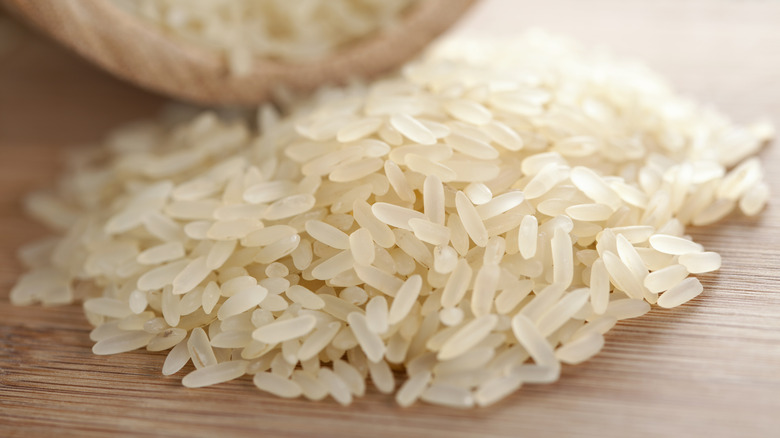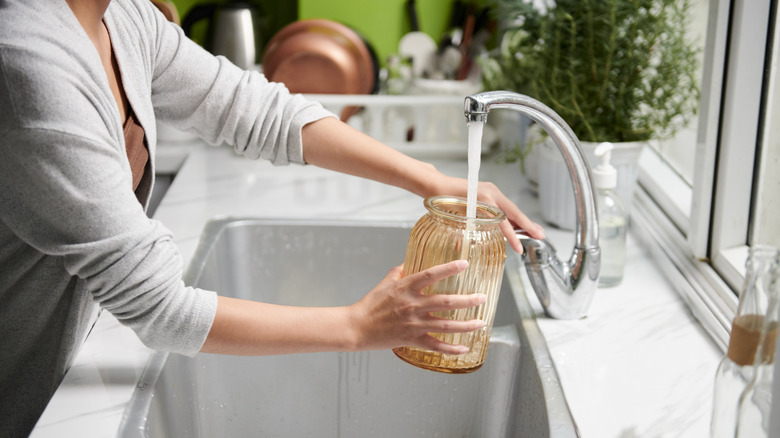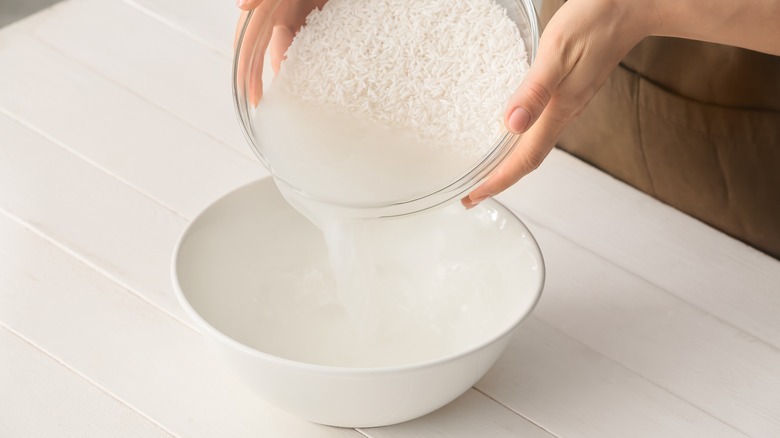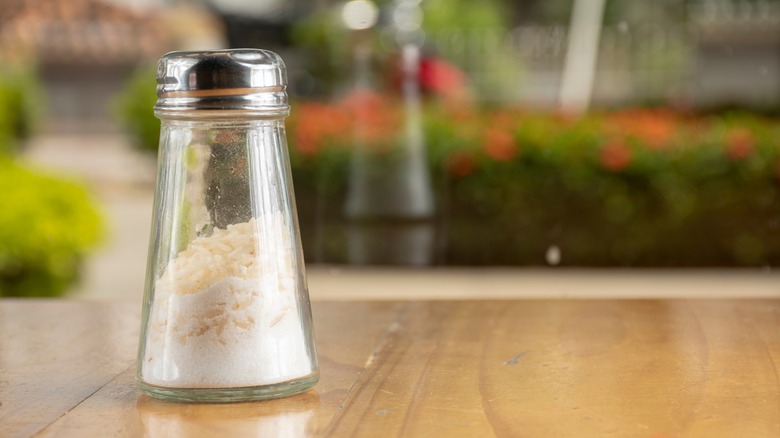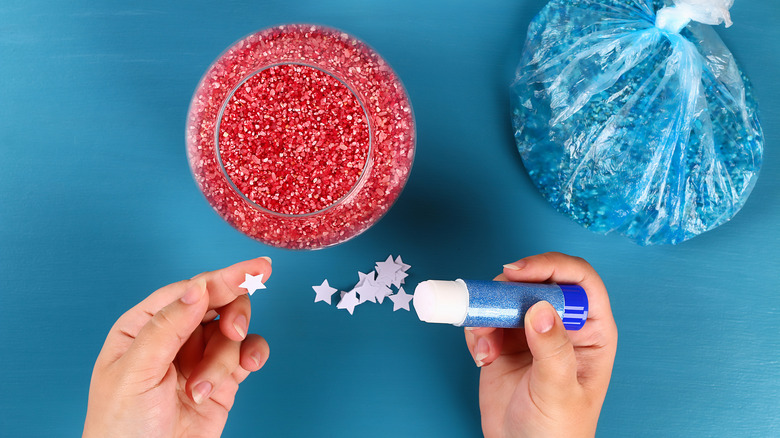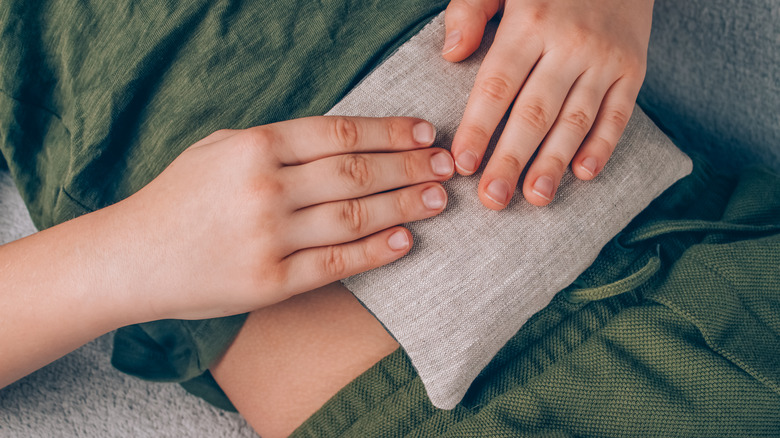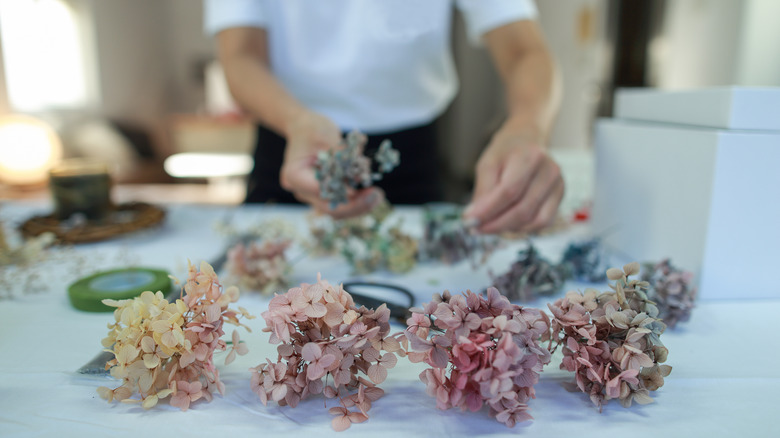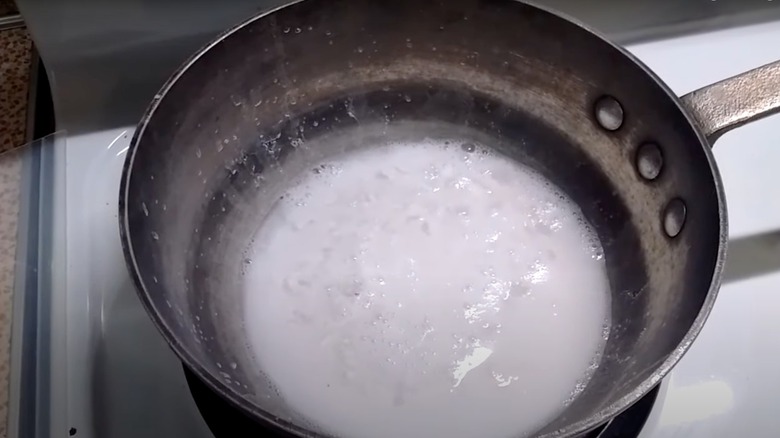Uncommon Household Uses For Rice
We may receive a commission on purchases made from links.
You might find rice on the table for breakfast, lunch, or dinner in many households. It's a staple in most kitchen pantries, and it turns out it's more than just a delicious side dish. Similar to other pantry basics like vinegar and lemon, it can be a cleaning powerhouse if you use it the right way. There are a few qualities that make rice a distinctive home helper. Uncooked rice is abrasive, but unlike similar food items like salt, rice doesn't dissolve when you mix it with water. This means it can keep scrubbing until you're finished with the cleaning job.
Rice is also a moisture absorber. It's hygroscopic, which means it will absorb moisture from the air when there is high relative humidity. This trait is useful for certain tasks around the home. Plus, with uses for decoration and deodorizing, these little grains are truly versatile. Best of all, since rice is so affordable and widely available, it can be a cheaper alternative to some home products. Looking to put that bag of rice to good use? Take advantage of these cleaning and homemaking tips using grains of rice.
Use rice as a scrubber for bottles, vases, and containers
Bottles, vases, containers, and other vessels can get build-up inside them that is difficult to clean. This is especially true when they have a narrow opening that you can't fit your hand inside. While you can get a bottle brush cleaner, like the OXO Good Grips Water Bottle Cleaning Set, this type of cleaning tool might not reach into very narrow or irregularly-shaped vessels. Not to mention, these cleaning brushes cost money and are often made of plastic, which some consumers might prefer to avoid for environmental or health reasons.
Grains of rice can really get into small and tight spaces for a good scrub — their abrasive texture can really cut through residue. It doesn't take much to get the job done. You only need about two tablespoons of rice, a few drops of dish soap, an optional splash of white vinegar, and a little bit of water. Put just enough water to allow the rice to shake and swirl easily, but without covering the rice completely. The grains of rice should be exposed so they can scrub the sides of the vessel (if they're immersed, they won't do as good of a job). Swirl and shake the rice around until all interior parts are clean, then discard the rice and rinse the vessel as usual. If this doesn't get the job done, you can add a dishwasher tablet into the container after washing and fill it with hot water. Let it sit overnight and then rinse out and it should remove any leftover fogginess.
Use rice water around the house and garden
If you've been throwing away your rice water, you're tossing useful liquid down the drain. This cloudy liquid has a few uses around the home. The first is as a gentler cleaner. Rice water is starchy, slightly acidic, and minimally abrasive. It can help remove grime, but it is gentle enough to use on most hard surfaces like glass, metal, and ceramic. Of course, if you have any doubts, give it a test on an inconspicuous spot). We particularly recommend it for cleaning water stains.
Rice water can also benefit your garden. It contains essential minerals like nitrogen, potassium, and phosphorus. It's prudent to do a soil test before adding fertilizer to a garden, even if it's as simple as rice water. You can buy a soil testing kit, like the Luster Leaf 1601 Rapitest Test Kit. Another option is to contact your state's Cooperative Extension Service, many of which offer soil tests for cheap or free. If your plants could use a nutrient boost, on one of your watering days, just replace your usual water with rice water. Rice water is suitable to use on indoor and outdoor plants. Just keep in mind that it's best to use it only about once a month to prevent excess bacteria or starch build-up in the soil.
Making rice water is easy. Next time you plan on cooking rice, let the rice soak for 30 minutes to 2 hours. You can play with the ideal ratio for your needs, but start with around a 1 to 4 ratio of rice to water. After soaking, pour the rice water into a bottle or container. Since the rice isn't mixed with any soap or other chemicals, you can eat it after (and it's already washed for you!). The rice should be cooked right away, but you can store the water in the fridge for up to a week.
Rice can work as a natural moisture absorber
As mentioned above, rice is naturally hygroscopic, which means it will absorb moisture from the air when the humidity is higher. You can harness this power to your advantage. While rice won't be as effective as say, a dehumidifier, it can help reduce moisture in some settings. One is in the workshop, to keep moisture away from tools and prevent them from rusting. One way to do so is to put a small cupful of rice inside your closed toolbox. If you're worried about the rice making a mess, you can funnel it into the sock part of a pantyhose, snip the extra, and then tie open top into a knot. Another option is to pour rice into a larger container that can fit your tools and to put the tools metal head side down into the rice. Either way, by reducing excess moisture, the rice reduces the likelihood of rust.
The same type of logic makes rice a good choice for absorbing water from your salt shakers or sugar storage — it takes some of the wetness out of the air and can prevent these food items from clumping. Put a small amount of rice directly into your salt shaker to keep it loose. It will absorb extra moisture and the larger grains can help break up salt clumps. For use in your white sugar storage, place rice in a small, porous bag and then put it in your sugar storage container, where it will help reduce damp conditions.
Make a simple natural deodorizer
Uncooked rice has a fairly neutral smell, which makes it a good material to make a deodorizer. It's natural too, so with the addition of essential oils, you can create a deodorizer that's completely free of synthetic chemicals. It's very easy to do so; just put some uncooked rice in a small container (you can start with ½ a cup and add more if you need), and mix in a few drops of essential oil to fragrance it to your liking. We recommend about 20 drops. You can mix different oils and add less or more depending on how strong you want it to smell. If you have pets, make sure to use essential oil that are safe for their species. After adding the oil, stir the rice to evenly distribute the fragrance.
You can tuck this container into an area that you want to smell nice, like in a bathroom or in the back of a closet. Make sure it's out of reach of children and pets — even if it's natural, it can be dangerous if ingested. If you're worried about the rice spilling, you can tie a cut pantyhose or cheesecloth over the opening of your container, which will let the scent out, but not the rice grains. Another option is to put your rice mixture into small sachets, which is great for storing in smaller areas like a wardrobe or your car.
Use rice for decoration
Home decor can be expensive, so for those on a budget, any opportunity for a cheap DIY is welcome. Rice can take the place of some home decor items, as well as improve the appearance of others. For example, if you're trying to set up dried flowers in a vase and they just aren't sitting the way you'd like, rice can come to the rescue. Fill a vase with rice, covering at least two inches of the bottom, and poke the stems of the flowers inside. The rice will help hold them in place. You can use a similar method to make an incense holder. Place some rice in a fire-resistant container (like a glass jar), reaching at least an inch in height. The grains can hold up almost any lightweight item, such as a stick of incense.
Looking for a creative way to create holiday decor? Use rice and food coloring! It's an especially fun activity for kids, and you can even use dyed rice for sensory bins. But if you put it in a pretty clear vase, it can make a fun, low-cost decoration as well. Think black and orange for Halloween, green and red for Christmas, or red and blue for 4th of July — if you can find the right food dye shade, you can craft something. The blog A Beautiful Mess recommends this method for making dyed rice: place a cup of uncooked rice in a plastic bag and add a couple of drops of food coloring, as well as one teaspoon of white vinegar (which helps prevent mold for longer). You can play with the amount of food coloring to get your desired shade. Seal the bag and shake, then spread the contents on a piece of wax paper. Once it has dried completely, the colored rice is ready to use.
Craft useful household items
There are plenty of household items you can make with the help of rice. Pretty much any item that is filled with beans for flexibility or weight can be filled with rice instead. Examples include a heat or cold pack, hand warmers, door stops, and door draft stoppers. You can even make a knife block in a pinch! If you've just moved and you're missing your knife block, fill a container with rice and stick the blades inside — it will hold the knives up and is safer than letting them loose in a drawer.
If you've ever carried a big bag of rice home from the grocery store, you know how heavy these little grains can be. This makes them a good filler for a homemade door stop or door draft stopper. If you have some basic sewing skills under your belt, you essentially want to make a pouch out of a heavy-duty fabric like canvas. Make a shorter, stout one for a door stop, and a long skinny one for a drafter stopper. Fill the pouch with rice and sew closed to create the finished product.
Rice also retains heat and cold, which makes it suitable for hot or cold packs and hand warmers. To craft either of these items, make a pouch out of a microwave safe material like cotton or linen. Choose a suitable size (larger for a hot or cold pack, and pocket-sized for a hand warmer). Fill it with rice and sew closed. To cool down the pack, place it in the freezer for a few hours. To heat it up, a zap in the microwave: about a minute for heat packs and thirty seconds for hand warmers.
Dry flowers for preservation
Whether from a graduation, anniversary, wedding, or other celebration, most of us come across flowers that we'd like to preserve at some point. There are a few ways to preserve blooms, the simplest of which involves air drying them by hanging them upside down in a dark, dry, and well-ventilated space. It usually takes flowers a couple weeks to dry this way, and they run the risk of developing mold.
To speed up the process, harness the moisture-absorbing power of rice. This method works with sturdy flowers like roses, dahlias, and marigolds — you'll want to choose flowers that can maintain their shape in a rice-filled container. Take a container that's large enough to comfortably fit your flowers. Place an inch or so of uncooked rice on the bottom. Place the flowers on top and slowly cover them with more rice. Seal the container and leave it for around a week. Once the flowers are completely dry, you can remove them and set them with hairspray, which will help preserve the blooms further.
Make rice glue for crafting and making DIY home decor
There are tons of different types of glue you can pick up at the craft store, but did you know you can make your own at home? If you're wary of the long, chemical ingredients list on some glues, make a natural version out of rice instead. Using rice as adhesive has a long history, dating 1,500 years back to ancient China, where sticky rice mortar was developed. Rice glue continues to be used in China and Japan for some crafts, particularly involving paper and wood materials. It dried clear, so it's a versatile glue.
Homemade rice glue works best with short-grain white rice (brown rice can leave husk pieces behind). Zero-Waste Chef recommends the following simplified method for making your own. This is the only DIY on our list that uses cooked rice, so it's perfect for if you have some leftovers you need to use. Blend together two tablespoons of cooked rice and an equal amount of water. If the mixture isn't smooth, add small amounts of water until it is. This will yield about two tablespoons of rice glue, so you can adjust amounts accordingly. Keep in mind that the unused glue should be stored in the fridge for up to a week, so you don't want to make too much at a time. Once blended, place the mixture in a pot and let it reduce until it has a paste-like consistency. Then you can use it for gluing!
